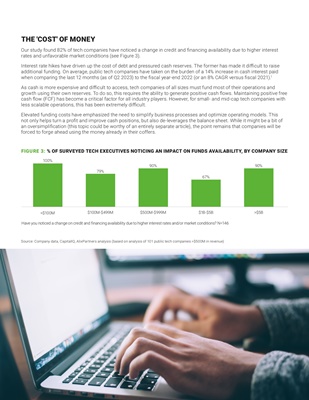
The great rebalancing act: Why tech is focused on profitability rather than growth, and why this is good for the industry 5
THE 'COST' OF MONEY
Our study found 82% of tech companies have noticed a change in credit and financing availability due to higher interest
rates and unfavorable market conditions (see figure 3).
Interest rate hikes have driven up the cost of debt and pressured cash reserves. The former has made it difficult to raise
additional funding. On average, public tech companies have taken on the burden of a 14% increase in cash interest paid
when comparing the last 12 months (as of Q2 2023) to the fiscal year-end 2022 (or an 8% CAGR versus fiscal 2021).1
As cash is more expensive and difficult to access, tech companies of all sizes must fund most of their operations and
growth using their own reserves. To do so, this requires the ability to generate positive cash flows. Maintaining positive free
cash flow (FCF) has become a critical factor for all industry players. However, for small- and mid-cap tech companies with
less scalable operations, this has been extremely difficult.
Elevated funding costs have emphasized the need to simplify business processes and optimize operating models. This
not only helps turn a profit and improve cash positions, but also de-leverages the balance sheet. While it might be a bit of
an oversimplification (this topic could be worthy of an entirely separate article), the point remains that companies will be
forced to forge ahead using the money already in their coffers.
Have you noticed a change on credit and financing availability due to higher interest rates and/or market conditions? N=146
FIGURE 3: % OF SURVEYED TECH EXECUTIVES NOTICING AN IMPACT ON FUNDS AVAILABILITY, BY COMPANY SIZE
90%
67%
90%
79%
100%
<$100M $100M-$499M $500M-$999M $1B-$5B >$5B
Source: Company data, CapIQ, AlixPartners Analysis (based on analysis of 101 public tech companies >$500M in revenue)